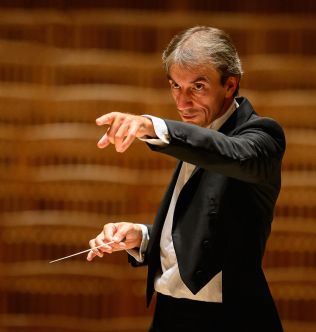|
Symphony
SRS SEASON ENDS WITH RESOUNDING TA-TA-TA-BANG
by Terry McNeill
Sunday, June 1, 2025
Symphony
YOUTHFUL VIRTUOSITY ON DISPLAY AT USO'S MAY CONCERTS
by Peter Lert
Saturday, May 17, 2025
Symphony
MYSTICAL PLANETS AND LIVELY GERSHWIN ORTIZ AT FINAL SRS CONCERT
by Peter Lert
Sunday, May 4, 2025
Symphony
VSO'S CONCERT MUSIC OF TIME, MUSIC OF PLACE
by Peter Lert
Sunday, April 27, 2025
Choral and Vocal
VOCAL ELEGANCE AND FIRE AT THE 222'S RECITAL APRIL 26
by Pamela Hicks Gailey
Saturday, April 26, 2025
CANTIAMO SONOMA SINGS AN INSPIRED GOOD FRIDAY MOZART REQUIEM CONCERT
by Pamela Hicks Gailey
Friday, April 18, 2025
DRAMATIC SHOSTAKOVICH SYMPHONY CLOSES PHILHARMONIC'S 25TH SEASON
by Terry McNeill
Sunday, April 13, 2025
LARGE COLLEGE OF MARIN AUDIENCE GREETS STOPHER ARTISTRY
by Terry McNeill
Saturday, April 5, 2025
Chamber
FRISSON DELIVERS SHIVERS OF DELIGHT
by Abby Wasserman
Sunday, March 30, 2025
OLD AND MOSTLY NEW IN SRS MARCH CONCERT IN WEILL
by Peter Lert
Saturday, March 22, 2025
|
 |
 Conductor Bruno Ferrandis |
COLORFUL FALLA AND PROVOCATIVE BRITTEN WORKS IN SRS WEILL HALL CONCERTS
by Terry McNeill
Monday, April 4, 2016
Current fashion in orchestra season marketing showcases themes, and it’s de rigueur now, from the fledgling Sonoma County Philharmonic to the august San Francisco Symphony. Some of these themes are inane, but the Santa Rosa Symphony’s set of three concerts beginning April 2, with the event title “Rhythmic Vitality,” was singularly appropriate.
In the April 4 Weill Hall concert Britten’s Cello Symphony (Op. 68) and Falla’s complete music from the ballet “The Three Cornered Hat” had rhythmic interest by the truckload. With cellist Zuill Bailey performing the demanding but often introspective solo, the Britten work from 1963 was provocative. It’s constructed in an unusual format of four movements, the final two linked by an instrumental cadenza, and though loved by virtuosos it has not been popular with the public.
Mr. Bailey made a strong case for the Symphony, working with conductor Bruno Ferrandis to considerable effect. It needs to be said that this is a difficult piece to initially like, and much audience reaction in the lobby at intermission seemed to confirm this. Surprisingly the soloist used both a microphone and a score, playing much of the work with little vibrato that allowed the upper register partials to clearly sound. One needed to look elsewhere for easy tunes, and Mr. Bailey, who I have admired in recent Napa and San Rafael performances, was at his best in the ruminating first-movement phrases and slashing attacks over flute and bassoon parts, and a knockout cadenza. From a balcony seat the cello tone sounded muddy and indistinct at places, contrasting with the lucid and sonorous orchestra.
Much low-drone cello playing and extended vibrato was heard in the short Presto and and the musical sun came out in the finale. Here the music rises to a luminous finish, and perhaps audience comprehension leading to a standing ovation.
Falla’s wonderful 1919 Ballet score received a performance of orchestral color and sparkling effects. The audience of 950 seemed to physically move with the unfolding of piquant Andalusian folk tunes and brassy sway, something foreign in the Britten. The music throughout suppresses string importance (save for bass and cello) and is a tour de force for winds. There was lovely playing from the clarinet (Roy Zajac), bassoon (Carla Wilson), oboist Laura Reynolds and Stacy Pelinka’s piccolo.
Mr. Ferrandis drew some exceptional Spanish colors from his orchestra, shaping the clarinet and harp (Dan Levitan) duo, the abbreviated piano parts and a scintillating pizzicato accelerando in the Sequidillas section. This piece needs the sure hand that Mr. Ferrandis has, always the picture of control and energy on the podium. The two passages for voice, totaling just 85 seconds, were sung by mezzo-soprano Bonnie Brooks, and past without much notice in the lush 40-minute composition
Opening the concert was New York composer Daniel Brewbaker’s Blue Fire, a 15-minute exploration of contrast and instrumental tint. The composer was in attendance and took three curtain calls, and spoke elegantly during the pre-concert talk alongside Mr. Bailey and Mr. Ferrandis. The 2013 premiere was at a Napa Valley summer festival
As with many freshly-minted orchestra works, it was heavy with loud timpani and brass, but there were rhapsodic and lyrical sections with echoes of Bernstein and movie scores. Movements (I counted two) are constantly shifting, with standout parts for tuba (Scott Choate), Ms. Reynold’s oboe and Mr. Zajac. The percussion and timpani sections were busy and chimes and marimba parts were distinct, unlike an inaudible piano part. Often in newer music the pianist can be seen but not heard.
Blue Fire ended with a long and orderly climax in the strings, a counterpoint to the frequent previous offbeat brass phrases and insistent incisive rhythms. As with the balance of the program it was Mt. Ferrandis’ triumph, his diligent command directing every facet of the music.
|

